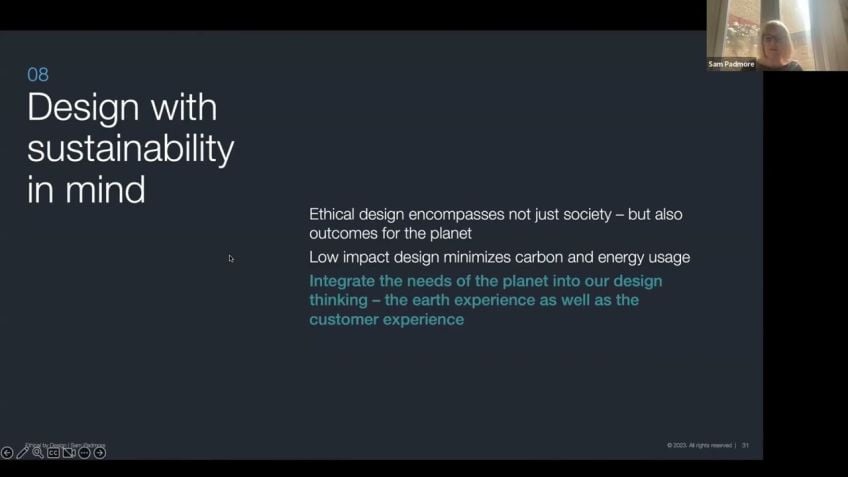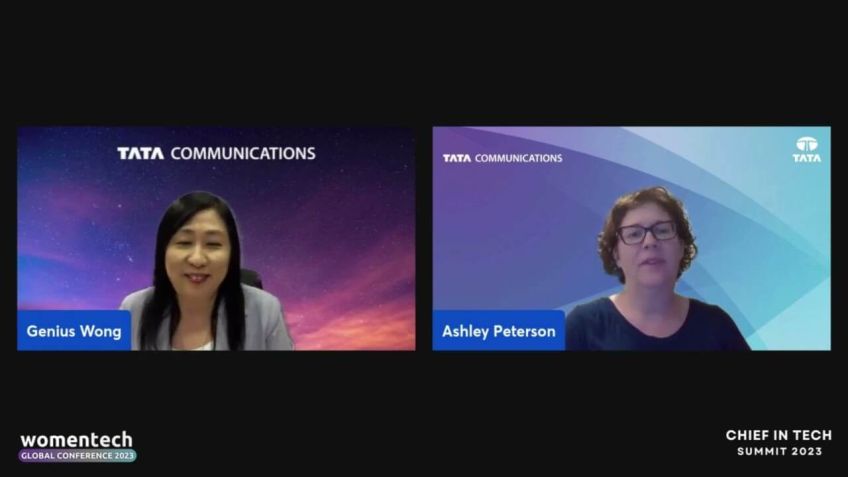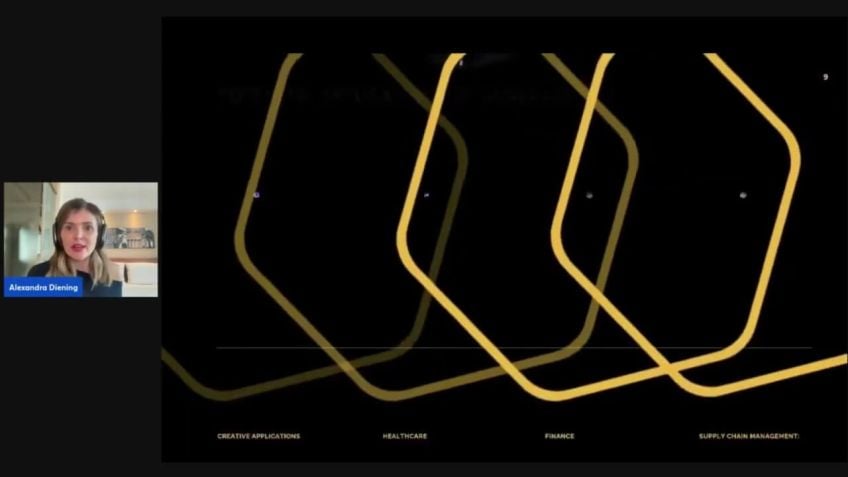Powering the Optical Network to build Internet of the future
Richa Daga
Software EngineerEmpowering the Optical Network for Future Internet
Welcome to our online conference series from the Global Women Tech Conference 2023. We're thrilled to dive into the intricacies of optical networks and how they're driving modern tech advancements.
Network Challenges & The Need for New Solutions
In tech, we witness new applications every day - IoT, 5G, AR, VR, AI have taken the world by storm. But their reliable functioning often calls into question. Ever thought about what if these technologies lose connectivity even for a second? Such an outage can question the very reliability and availability of these new applications. The solution lies in the recent advancements in the technology that ensure smooth and reliable operations. In the following session, we delve deep into powering the optical network to build the future internet.
About the Speaker
I’m Richard Dagger, and I bring over a decade of experience in optical fiber technologies to this presentation. Having worked with Cisco engineering for the mass scale infrastructure group, I'm passionate about technologies and chipsets that connect the world. I'm also a technical speaker at various other global industry conferences and an Amazon best-selling author.
Creating Internet Connectivity Through Optical Networks
Can you remember the one thing you ensured was working before joining the conference? That is, undoubtedly, an internet connection. Not just the backbone for this virtual interaction, internet connectivity is shaping our lives. It is made possible via optical networks, which carry data in the form of optical channels or wavelengths.
The Power of Optical Networks
Optical networks ensure we achieve terabytes of speed in the digital world. These networks utilize the L band spectrum to fulfil high bandwidth requirements. They comprise different optical components that allow us to generate a basic understanding of their functioning.
Understanding the Optical Spectrum
The C and L bands are regions of the optical spectrum through which our data travels in an optical network. As bandwidth demands continue to grow exponentially, we need to explore the L band frequencies and ensure network operators can make a seamless switch between the two bands.
Delving Deeper into Optical Networks
Optical networks utilize several components, including:
- Optical transceivers
- Optical add drop multiplexers
- Optical amplifiers
All these components ensure that data can smoothly move through optical fibers and help optimize wavelength performance while fulfilling bandwidth demands.
The Evolution of Optical Networks
Optical networks need constant evolution in order to meet rapidly changing technology demands. From add-drop multiplexers to programmable versions and beyond, the driving force for these developments is the need for flexibility and remote control.
Understanding ADR (Automatic Power Control)
ADR provides control over each channel’s optical power, preventing OSNR deterioration of the optical transmission link. It corrects amplifier power or gain depending on capacity changes, fiber aging effects, and operating conditions.
The Future Internet Builders
Choosing the right solution with all the advancements in different components is instrumental in building the internet of the future. The future of the internet relies heavily on optical networking solutions and optical components that drive connectivity.
Conclusion
Thank you for tuning in for this informative session. We hope it shed some light on the topic of optical networking solutions. As we just scratched the surface of this complex topic, don’t hesitate to reach out for a deeper dive. You can catch up with me via LinkedIn for a more detailed conversation.
We thank the Women Tech Network for organizing another insightful edition of the Global Women Tech Conference. Feel free to continue the discussion in the comments below or via direct messages. Stay tuned for more enlightening sessions!
Video Transcription
Hello everyone. A very warm welcome to the Women Tech Network Global Conference 2023 key tech summit.I hope you are feeling enlightened and enjoying the insightful talks at the conference which started yesterday and brings together 100,000 women in tech to drive change with purpose and impact in 181 countries. I would like to welcome you all to another exciting session that has everything in store to ride the ongoing as well as future bandwidth demands posed by the latest technologies. So before beginning and diving into the session ahead, I want you to think about this with technologies such as IOT five G artificial reality, virtual reality artificial intelligence, marking its presence in almost all fields. What can be the potential risk for their functioning?
What if imagine the internet of things or the different applications of these technologies somehow go out of connection for a second such a scenario or an outage can mark questions on the very reliability and availability of these new applications. So if you think for a moment that where lies the solution that all the recent advancements that have happened in technologies can proceed smoothly and this is what we are going to discuss in this session ahead. I am Richard Dagger and I feel privileged to have the opportunity to deliver the session on powering the optical network to build internet of the future. A little about me, I'm working in Cisco engineering for the mass scale infrastructure group and I'm passionate about technologies and chip sets that are connecting the world. I have more than a decade of work experience on optical fiber technologies, chip sets and hardware that is making terabytes of speed possible in this digital world. Today, I won the women take global conference speaker of the year award last year and it's a delight to be back at the event. Again.
I'm also a technical speaker at various other global industry conferences such as the IUT Slam I Triple Smart Cities Sub Optic conference and I Triple Women in Engineering International Leadership Conference. I'm also a published author of an Amazon bestseller that captures my journey and features myself as a global women change maker with the women in tech opportunities that are coming along with their way. I also started the India chapter of women in science and engineering community of Cisco which aims to bring more women into leadership roles. So coming to the agenda for the talk today, which is everything technical. I would like to ask you all one simple question. So what makes all the latest technologies and even are this virtual interaction possible? Yes, I know, before beginning, you knew that you had to join the conference. So what was the one thing that you ensured was working? Right. So that is what has become a ubiquitous part of our lives. And that is the internet connection and internet is made possible through optical networks. And how does that happen? What do these optical fibers carry? Of course data, as we proudly say, gigabits of speed is there and it's actually now terabytes of speed possible today.
So as we say that optical fibers carry data, what are they actually carrying that is wavelengths and the wavelengths can be said as optical channels which belong to the optical spectrum. So we would touch upon the use of L band spectrum which makes possible the high bandwidth requirements of today's world. And it's not just that to understand how data travels from one place to another, we need to go into a little detail of advanced rode that is reconfigurable optical a drop multiplexer which optimize wavelength performance and help to meet the exponential bandwidth demands of the digital world.
Also, as we would dive into what are the different optical components that comprise the optical systems to get a basic idea about these exciting and insightful areas that we will be covering in this session. First of all, let's have a view of the optical spectrum. So this is the infrared region of the spectrum and C band that is the conventional band lies around 1550 nanometer wavelength and L band lies around 1625 nanometer for a single mode optical fiber. And if you have a look here, this figure depicts the different wavelengths that is optical channels around the C band. That is you can see the center channel is located at 15 52.52 nanometer or 1 93.1 terahertz. So it depicts in both the units that is wavelength and frequency, which is actually a simple formula that is we have studied in our vex that wavelength is equal to velocity of light divided by frequency. Now, when I say that we had to move towards using the L band spectrum as well, that is this region of the infrared. Why was the initial C band that is still used? Not enough because as bandwidth demands continued and are continuing to grow exponentially. Next generation transponders provided incremental capacity improvements. But we started reaching the Shannon's limit. A key approach then came in to tackle this bandwidth issue by extending into the L band frequencies to double capacity of our networks.
Today solutions are there which offer both C band and L band frequency solutions. So if the network operators need to remain ahead, the solution should be chosen that a hitless migration to CL bandwidth from the C band is possible in case of high bandwidth requirements. Also do have a look at this optical fiber cable which carries the wavelengths that I was talking about that is channels for your understanding of the next lights. So going into a little deeper into optical networks, let's first understand the optical components that make the whole picture possible.
I know it would be really difficult to explain everything in detail. So I'm trying to touch upon the surface areas which are important to build up understanding on this topic. So optical transceivers are used for optical to electrical and back to optical conversion. Here you can see optical transmitter is doing electrical to optical conversion so that data can go over the fiber which wants optical data to flow over it. And when the data is received, it's converted back to electrical by the optical receiver that is called the OE conversion.
To understand the WDM innovations. Further in the slides ahead, here's a picture that highlights it N pulses of different wavelengths are multiplexed and send over the D WDM fiber and DW DMV actually means is what it is doing right now. That is multiplexing. So it is dense wavelength division multiplexing. And if we have different wavelengths getting multiplexed ones, there can be a possibility that as longer distances are traveled a wavelength that is a color, it needs to be dropped to serve its intended location and further a new wavelength signal might need to get added. So this is done by the O AM. That is the optical add drop multiplexer which can have the wavelengths get dropped all the remaining wavelengths get passed through and the new wavelengths get added. So this is this, we talked about optical add drop multiplex. So that is the O AM but in today's world which thrives on flexible solutions everywhere, Rodham short for reconfigurable ag do multiplexer, it made its way. So here you saw the O AM next, what we are about to discuss is a row ro AD M that is called a rode and it is a programmable version of odem.
Now this adds the ability to remotely switch traffic from wavelength division multiplexing system at the wavelength layer. When I talk about remotely switch traffic, because now the internet is connecting every nook and cranny of the world. We cannot have operators or technicians going at different places to connect these optical fibers. That is that is we want to reroute the wavelengths. That is why flexibility, remote flexibility became so important that just sitting here we can control that. OK. What data needs to go at which date center and this connectivity can be made throughout the world. So this is achieved like roden could achieve this objective through the through the use of wavelength selective switch that is called AWS S component within the device ROM line card.
It creates an A G dense wavelength division multiplexing that is AD WDM layer which provides the foundation for converged transport architectures, delivering features that allow programmability and agility in provisioning and recovery operations. Now wavelength ADR and routing hence became entirely software driven, eliminating any manual operator that has to come into the picture. And this reduced a lot of operating expenses. That is the OPEC and accelerated provisioning and recovery. Now, talking about rodents, as we want to talk about the future of the internet that we are discussing right now. And from odem like fixed optical aro multiplexer, we came to rodents. But rodents are also of three types. That is the CDC rodents. They are necessary to overcome the limitations of the traditional rode which gains static flexibility. If you see her colored add drop, it meant a fixed port frequency assignment. That is one unique frequency per port. Now colorless rode, which is an advanced version, these ports are not frequency specific.
They simplified the provisioning and allow dynamic restoration. That is if something fails dynamically, we can restore the connection because the frequency of an RIS channel, it can be retuned without requiring the fiber to be relocated. So there can be any frequency that is any color on any port.
If we are having the colorless colorless ADR rods, the next thing in CDC rode is D that is direction. So directional add drop meant physical add drop port is tied to a rode degree. And if we talk about the omni direction, that is a direction less that rode eliminated the mapping between the physical add drop port and the rode degree for a specific direction. So now as we moved into advancements further. That is from color to color, less, from directional to directional. The frequency and direction of the signal can be changed without requiring a change of rodent at drop port. So therefore, it brought us programmability. But another problem came in as that colorless and omnidirectional introduced wavelength contention at the ADR stage, which needed a contention less architecture. So this is the next next important characteristic of the rode that we should, we should ensure that is contention less.
So contention less ADDr allows an N degree rode to accommodate N wavelengths of the same frequency from a single ADDr device. And this is what characterizes a CDC rode that is colorless, directionless and contention less what we saw in the previous slides. Now this is an optical amplifier because if you would think about data going on the optical fiber, then can I just keep on going or will it get attenuated as well attenuated as in the power would reduce of the data, which is traveling and hence, we need to amplify it. That is where an optical amplifier became important. And to understand it's working, we can go into a little bit of chemistry about ions and electrodes. So here is the fa that is, that is what we call as the RBM doped fiber amplifier working in principle. So you can see here a pump laser comes in that is a 980 nanometer pump photon which you can see here, once it sim stimulates the RBM doped fiber. Here, this is the fi uh optical fiber which is RBM doped. So when this is excited by a pump that is 980 nanometer pump photon, the albion ion is stimulated from the ground state to the high energy state which is called the E three. This is the high excited state but it is unstable. And therefore the albion ion soon undergoes radiation less decay and comes to this E two metal stable state where the photons are not released.
But then optical signal which we discuss that is about 15 nanometer, they traverse this rpm doped fiber particles at this E two metastable state transit to the ground state in stimulated radiation mode and generate the same photons as the incident light. So in this way, photons and the signal light are increased and signals are continuously amplified when traversing the IBM doped fiber. This is to provide you the whole picture of what we discussed that this data is coming to the transponders then going over the optical amplifiers and optical ADDr multiplexer, a new wavelength can get added or can get dropped. And here you can see that the optical to electrical conversion is happening. So this is the entire DWDM system, which is in fact making the internet possible today. And as you would understand that we're talking about internet of the future, so evolutions are keep going on happening.
Now RDM is one part but why did it require evolution? Because the answer is it's a complete ecosystem. If there are technology innovations happening in one area, the related areas also need to evolve to support these innovations. So as coherent transceivers came in and open optical networks became possible, rodents had to evolve to support wavelengths from third party transceivers to remove vendor lock in. And moving ahead. You can see here the other components which are, which make the advancements in which make possible.
The to address the bandwidth demands of today are the WSS. The first one which the enhancements are such that include 6000 gigawatts in the C band and 9600 gigawatts with C and L band, which itself has evolved from a separate WSS to a single C plus LWSS. And if we talk about amplifier innovations, so there has been a trend towards hybrid amplification combining fa that we just discussed along with Raman amplifiers that work on a different principle in order to reduce noise. So noise is something that can creep in if data going over the optical fibers. And this is another thing that is called the OC M because when data is going on in the fiber, you also have to monitor it. So cm is optical channel monitor which provides the ability to monitor the power level of each wavelength. And another important thing is what I need to tell you is that per channel optical power equalization is required because channel power can be unequal to the different insertion losses that happen in the fiber. So for amplifiers to operate correctly, the controlling the optical power of each channel in an optical network is important to prevent the osr deterioration of the optical transmission link.
An A PC that is automatic power control is well such optical application that automatically corrects the amplifier power or gain for capacity change, fiber aging effects as well as operating conditions. There also have been innovations in optical supervisory channels and OTD R that is optical time domain reflect to meter that transmit pulses of light into the fiber under testing and then analyze the light that is returned through scattering and reflection. Next, you can see here this is what a real life optical line terminal looks like, which has a pre amplifier, a boosted amplifier, AWS S which I was talking to talking to you about that is twin Flex WSS embedded OTD R hair optical supervisory channel with a two plus two switch.
So this t it gives the various benefits as we discussed in the rode evolutions. And so it depends on the network operators to weigh the offering of the various service providers and then take the decision to deploy that solution in the network because choosing the right solution with all the advancements in the different components that we discussed makes the difference in building the internet of the future.
So this is something that I have picked up from our Cisco and CST in product that we are supporting right now. If you want to read more about it and I can share the link as well. So this is what I discussed while discussing about that image later. And yes, so thanks for being with me in this session. I hope it gave an idea about the optical networking solutions and the optical components that power the heart that is connectivity of today's technologies. And if you have any questions further on optical networks, do get in touch with me at my linkedin. I would love to discuss in detail as we were just riding the surface of optical networking, we can go much deeper into these solutions to enhance our understanding. Also, I would like to thank the women Tech Network for organizing yet another wonderful edition of the Global Women Tech Conference. Do enjoy and catch up rest of the sessions ahead. And if you have any questions, I'm running short on time, you can post them in the chat section. I'll pick them later. Plus do message me on linkedin for any queries that you have. Thanks a lot for being with me throughout this session. Thank you. OK.






